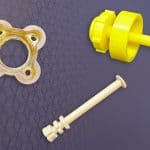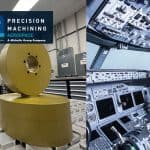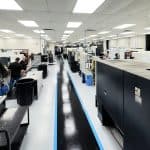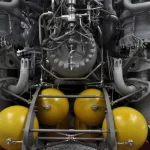
Aerospace plastics can reduce aircraft weight by 50% compared to metal parts, significantly improving fuel efficiency and operational costs. With exceptional thermal properties, materials like PEEK withstand temperatures up to 500°F (260°C), while CELAZOLE (PBI) maintains stability at an impressive 750°F (399°C). This remarkable performance explains why the global aerospace plastics market reached $7.61 billion in 2023 and is projected to grow to $13.89 billion by 2030.
High-performance aerospace plastics offer compelling advantages beyond weight reduction. Aerospace polymers like Vespel® demonstrate exceptional thermal stability for high-temperature applications, while also serving semiconductor manufacturing needs due to low outgassing properties. Furthermore, aerospace grade plastics such as Ultem® (PEI) provide versatility with FDA and NSF approval for food and medical contact. Additionally, the trend toward using these advanced materials dates back to World War II, when engineers first recognized the potential of polymer composites for structural integrity. The switch to plastic materials is also set to lower maintenance requirements by 20%, making high-strength plastics increasingly attractive for the aviation industry.
Key Selection Criteria for Structural Aerospace Plastics
Selecting the optimal materials for aerospace applications requires meticulous evaluation of multiple performance criteria. High-performance aerospace plastics must meet stringent requirements to function reliably under extreme conditions throughout their service life.
Thermal Load Requirements in Aircraft Structures
Temperature resistance stands as a primary selection criterion for aerospace polymers. Aircraft engines can reach temperatures up to 3812°F (2100°C), creating extreme thermal demands on surrounding components. Consequently, aerospace grade plastics must maintain structural integrity and mechanical properties under these challenging conditions.
Glass transition temperature (Tg) and melting point (Tm) serve as critical indicators when evaluating thermal performance. For instance, PEEK demonstrates exceptional thermal stability, maintaining dimensional integrity at temperatures up to 480°F (249°C). This property makes it particularly valuable for components that experience significant thermal stress. Moreover, PEEK carries a V-O flammability rating with minimal smoke and toxic gas emissions when exposed to flame.
Thermosetting polymers offer particular advantages in aerospace applications because, unlike thermoplastics, they do not melt upon reheating. Instead, these materials form three-dimensional networks that provide enhanced structural integrity under heat and pressure. This characteristic proves essential for components that must withstand both high temperatures and mechanical stresses simultaneously.
Chemical Exposure in Fuel and Hydraulic Systems
Aerospace plastics frequently encounter harsh chemicals, including aviation fuels, hydraulic fluids, and cleaning agents. Hence, chemical resistance represents another crucial selection factor.
Polysulfone demonstrates superior resistance to:
- Inorganic acids and bases
- Hydrocarbon oils and detergents
- Steam and hot water exposure
- Radiation environments
This exceptional chemical stability makes polysulfone particularly valuable in fuel system applications, where it maintains structural integrity when exposed to aviation fuels and hydraulic fluids. Similarly, PEEK exhibits outstanding resistance to chemicals, aircraft fuels, and steam, ensuring long-term reliability in critical systems.
Notably, moisture absorption presents a significant challenge for aerospace polymers. Even minimal moisture exposure can affect performance—materials experiencing just 0.25% weight gain show a 10% increase in inter-laminar shear strength. High-performance polymers like PEEK, PPS, and PAI have emerged as preferred choices primarily because of their exceptional resistance to moisture absorption.
Mechanical Stress and Fatigue Resistance
Prevention of fatigue failure in structural parts has been an important concern in aircraft engineering for many years. Aerospace components frequently endure extreme mechanical loads, requiring materials with high tensile strength, impact resistance, and durability under cyclic loading.
Fiberglass reinforced materials have demonstrated satisfactory mechanical properties for aircraft use, characterized by high tensile strengths. However, their compressive strengths, which are more important in aircraft applications, are somewhat lower. The fatigue strength of these composites typically ranges from 25% to 30% of initial ultimate strength.
Mechanical property changes under environmental conditions must also be considered. In bisphenol-based carbon/epoxy composites, tensile strength retention rates drop to 88.282%, 76.34%, and 66.43% respectively for different variants when exposed to moisture. Their compressive strength retention rates similarly decrease to 53.15%, 74.26%, and 83.45%.
Beyond standard mechanical properties, impact resistance proves essential when considering potential collisions with foreign objects. High-performance aerospace plastics must demonstrate both strength and toughness to prevent catastrophic failure from impact events.
Material Profiles: Comparing Top Aerospace Polymers
High-performance polymers represent the backbone of modern aerospace construction, with each material offering unique combinations of properties suited for specific aircraft applications. Engineers must thoroughly understand these materials’ characteristics to make optimal selections for critical components.
PEEK: High Strength and Biocompatibility
Polyetheretherketone (PEEK) stands as one of the highest performing thermoplastics globally, offering exceptional strength-to-weight ratios that make it ideal for aerospace applications. This remarkable polymer maintains its mechanical properties at elevated temperatures, with tests confirming a continuous use temperature of 260°C (500°F). PEEK demonstrates outstanding resistance to chemicals, aircraft fuels, and steam without degradation, ensuring long-term reliability in critical systems. This extraordinary durability, coupled with PEEK’s natural radar-absorbent properties and thermal insulation capabilities, makes it particularly valuable for military vessels and aircraft relying on stealth technology.
Vespel®: Superior Wear and Vacuum Compatibility
DuPont™ Vespel® represents a polyimide plastic specifically engineered for high-heat environments where conventional thermoplastics lose their mechanical properties. Unlike competitive thermoplastic materials such as Torlon® PAI or PEEK, Vespel® SP materials exhibit no observable glass transition temperature or abrupt softening point. This property enables Vespel® to function at significantly elevated temperatures—capable of operating at 500ºF continuously and enduring temperatures up to 900ºF for limited periods.
Beyond thermal resistance, Vespel® demonstrates exceptional performance in vacuum environments. For decades, this material has been used successfully as a replacement for ceramic seals and gaskets in ultra-high vacuum (UHV) conditions. According to the ASTM E595 standard developed by NASA, Vespel® exhibits low and acceptable levels of outgassing under vacuum. Studies have further shown that Vespel® SP-1 helium permeation levels at room temperature are approximately one-third those of PEEK.
In demanding wear applications, Vespel® has established an impressive track record. Specifically, Vespel® SP-21 thrust bearings have been found to survive pressure-velocity (PV) conditions as high as 400,000 psi-ft/min. Indeed, Vespel® parts for military, commercial, and industrial aircraft engines offer low wear and friction, broad temperature compatibility, and self-lubrication.
Torlon: Dimensional Stability and Flame Resistance
Torlon polyamide-imide (PAI) delivers exceptional performance in extreme conditions, offering more strength at temperatures up to 500°F than other engineered plastics exhibit at room temperature. Remarkably, it demonstrates superior impact resistance at cryogenic temperatures compared to other high-strength polymers.
In direct comparison tests conducted by Solvay Advanced Polymers, Torlon 4435 outperformed both Vespel® SP-21 and bearing-grade PEEK 450FC30 under various extreme velocities and pressures. At low velocity and high pressure, both Vespel® and PEEK samples failed, whereas Torlon 4435 performed exceptionally well. Additionally, at medium velocity and medium pressure, Torlon 4435 showed a lower wear factor than Vespel®, while the PEEK sample failed completely.
Regarding mechanical properties, Torlon 4435 offers superior tensile strength (107 MPa) compared to Vespel® SP-21 (62 MPa), though slightly less than PEEK 450FC30 (141 MPa). Furthermore, Torlon demonstrates excellent dimensional stability even at elevated temperatures, with a glass transition temperature of 280°C (536°F) compared to Vespel’s approximately 360°C (680°F) and PEEK’s 143°C (289°F).
Given these distinctive properties, Torlon has established itself in critical aerospace applications including aerospace thermal isolators, bushings, screws, tubing, and spacecraft precision moving parts.
Application Mapping: Matching Plastics to Aerospace Components
Strategic selection of aerospace plastics for specific aircraft components requires matching material properties with operational demands. Each polymer excels in particular applications based on its unique performance characteristics.
PEEK in Flight Control and Engine Systems
Polyetheretherketone (PEEK) has become essential in critical flight control systems where reliability is paramount. Flight control components, fuel system elements, and engine-related parts frequently utilize PEEK primarily due to its exceptional strength-to-weight ratio and resistance to extreme temperatures. As a result, aircraft manufacturers achieve substantial weight reductions—up to 60% when converting metallic components to PEEK—directly contributing to improved fuel efficiency.
In practice, PEEK’s thermal stability makes it ideal for engine casings, seals, and thrust washers that must endure temperatures up to 500°F (260°C). The material’s chemical unreactivity allows it to withstand constant exposure to aviation fuels and hydraulic fluids without degradation. Correspondingly, PEEK is extensively used in convoluted tubing that protects critical electrical systems throughout the aircraft.
Request a quote for custom-machined aerospace polymer parts engineered to your specifications.
Torlon in Powertrain and Transmission Parts
Torlon polyamide-imide (PAI) excels in aerospace powertrain and transmission applications where components face extreme mechanical stress. Essentially, Torlon maintains its mechanical properties at temperatures up to 500°F (260°C), making it ideal for bushings in blocker door assemblies. These components must deliver precise performance while experiencing temperature fluctuations from -40°F to 500°F without lubrication.
In the F-16 fighter, Torlon 4203 replaced metal connectors in fuel and air systems, subsequently improving both performance and manufacturing costs. This material effectively handles pressures beyond 650 psi while remaining chemically resistant to jet fuel. Likewise, Torlon has become standard for aerospace fastening screws where electromagnetic interference transparency is critical for radar system operation.
Ultem® in Cabin Interiors and Ventilation Systems
Ultem® polyetherimide (PEI) serves numerous applications throughout aircraft cabins, initially gaining popularity for its exceptional balance of properties. This material’s flame resistance and minimal smoke production fulfill stringent FAA regulations for passenger safety.
Throughout modern aircraft, Ultem® appears in:
- Ventilation systems and personal service units
- Food service equipment including ovens and beverage dispensers
- Interior components like latches, hinges, and door handles
Naturally, Ultem®’s electrical insulating properties make it excellent for oxygen panels and connectors. Its low thermal conductivity allows parts to function as thermal insulators. Presently, aircraft manufacturers are incorporating Ultem® 1668A sheet in seatbacks, armrests, magazine holders, and tray tables—applications requiring multilayer approaches for demanding interior environments.
Processing and Manufacturing Considerations
Manufacturing methods significantly impact the performance of high-performance aerospace plastics, with each process offering distinct advantages for specific applications. Selecting the appropriate manufacturing technique directly affects component quality, cost, and production time.
Injection Molding vs. CNC Machining for PEEK
Manufacturing PEEK components for aerospace applications can follow two distinct paths. Injection molding excels in high-volume production where consistent part replication is essential. This process becomes cost-effective for large production runs despite requiring significant upfront investment in tooling. In contrast, CNC machining offers superior precision for PEEK components with tighter tolerances than injection molding can achieve.
For aerospace engineers developing critical components, CNC machining provides several advantages:
- No special tooling requirements, making it cost-effective for small to moderate production runs
- Greater flexibility with part geometry, allowing complex designs
- Ability to achieve tighter tolerances than injection molding
Nevertheless, when production volumes increase, injection molding delivers compelling benefits through dramatically reduced per-part costs. Request a quote for custom-machined aerospace polymer parts engineered to your specifications.
Post-Curing Cycles for Torlon® Durability
Torlon® PAI polymer represents a unique case among aerospace plastics, requiring specialized post-processing. Freshly molded Torlon® parts are relatively weak, brittle, and exhibit poor chemical and wear resistance. Therefore, post-curing becomes an essential manufacturing step to achieve optimal performance.
The post-curing process involves placing parts in a forced-air oven with incrementally increasing temperatures over an extended period—sometimes requiring up to 21 days. Throughout this thermal treatment, Torlon®’s molecular weight increases through chain extension, dramatically enhancing tensile strength, toughness, and wear resistance. Remarkably, post-cured Torlon® offers 1/10th the wear rate and double the limiting PV (pressure-velocity) tolerance compared to non-post-cured material.
Thermoforming Capabilities of Ultem®
Ultem® (PEI) demonstrates exceptional versatility in processing methods. While commonly injection molded, Ultem’s thermoforming capabilities offer compelling advantages for aerospace applications. During thermoforming, Ultem sheets are heated to a malleable temperature, shaped in a mold, and trimmed to create functional components.
Thermoforming Ultem® provides significant benefits including:
- Lower tooling costs—just 25-50% of the investment required for injection molding
- Faster production cycles with lead times as short as 4-6 weeks
- Greater design flexibility for complex geometries
These advantages make thermoformed Ultem® ideal for aircraft cabin interiors, including seating components, window shades, and decorative elements. Additionally, Ultem®’s exceptional performance in thermoforming yields increased tensile strength, rigidity, and dimensional stability compared to alternative materials.
Future Trends in High-Performance Aerospace Plastics
The aerospace industry currently embraces numerous technological innovations that promise to transform how high-performance plastics are manufactured and utilized. These emerging trends aim to enhance both performance and sustainability while meeting increasingly strict regulatory requirements.
Additive Manufacturing with Aerospace Polymers
Additive manufacturing (AM) technologies are rapidly gaining traction in aerospace applications. This approach can reduce manufacturing cycle time by 80 percent compared to traditional methods. The polymer-based AM process offers several advantages over metal 3D printing, primarily through:
- Fewer processing steps resulting in faster production
- Reduced material waste compared to subtractive manufacturing
- Lower energy consumption through out-of-autoclave processing
High-performance polymers including PEEK and ULTEM® increasingly serve as primary materials in aerospace 3D printing applications. The FDM (Fused Deposition Modeling) technology stands out as one of the most user-friendly AM processes, requiring minimal specialized training while delivering fast solutions for engineering needs.
Composite Reinforcement with Carbon or Glass Fibers
Fiber reinforcement continues to revolutionize aerospace polymer applications. Carbon fiber reinforced plastics (CFRPs) increasingly appear in primary structures like wings and fuselages. Through strategic composite design, manufacturers achieve weight reductions of up to 50 percent compared to metallic solutions.
Glass Fiber-Reinforced Plastic (GFRP) represents another valuable option that exhibits an exceptional strength-to-weight ratio. Although it offers similar properties to carbon fiber composites, GFRP can be produced at significantly lower cost. Thermoplastic composites further enhance this performance through superior impact resistance—essential for withstanding bird collisions—while maintaining high productivity.
Sustainability and Recyclability Challenges
Sustainability gradually becomes a central focus in aerospace manufacturing. Traditional aircraft components made from bonded metallics and thermosets require energy-intensive autoclave curing. Conversely, thermoplastic composites utilize more efficient manufacturing processes that substantially reduce energy usage.
Recycling composite materials presents significant technical challenges. Currently, three main approaches exist: mechanical recycling (grinding), thermal recycling (pyrolysis), and chemical recycling with solvents. Each method offers different advantages regarding fiber quality preservation and environmental impact.
Projects like Airbus PAMELA demonstrate encouraging progress, showing that up to 90 percent of an aircraft can potentially be recycled. Additionally, the European HELACS initiative focuses specifically on dismantling and recycling large composite structures to support climate-neutrality targets.
Conclusion
Advanced aerospace plastics continue to transform modern aircraft design through exceptional weight reduction, thermal resistance, and mechanical performance. These high-performance polymers now serve as critical components throughout aircraft structures, reducing weight by up to 50% compared to traditional metal parts. Consequently, this significant weight reduction translates directly into improved fuel efficiency, reduced emissions, and lower operational costs.
The selection process for aerospace plastics requires rigorous evaluation across multiple performance criteria. Thermal stability stands paramount, with materials like PEEK withstanding temperatures up to 500°F while CELAZOLE maintains structural integrity at an impressive 750°F. Additionally, chemical resistance proves equally crucial as components face constant exposure to aviation fuels, hydraulic fluids, and cleaning agents. Mechanical properties, especially fatigue resistance, must meet stringent requirements throughout the aircraft’s service life.
Each high-performance polymer offers distinct advantages for specific applications. PEEK excels in flight control systems and engine components due to its exceptional strength-to-weight ratio. Likewise, Torlon® demonstrates superior performance in powertrain applications where components experience extreme mechanical stress. Ultem®, meanwhile, dominates cabin interiors because of its flame resistance and minimal smoke production.
Manufacturing techniques significantly impact component performance and cost-effectiveness. CNC machining provides greater precision for critical components with tight tolerances, though injection molding offers economic advantages for higher production volumes. Post-processing requirements, particularly Torlon®’s extensive post-curing cycles, must factor into production planning and timelines.
Looking toward the future, additive manufacturing promises to revolutionize aerospace polymer applications through reduced manufacturing cycles and material waste. Fiber reinforcement technologies continue advancing, allowing even greater weight reduction while maintaining structural integrity. Though sustainability challenges remain, particularly regarding composite recycling, initiatives like Airbus PAMELA demonstrate encouraging progress toward circular manufacturing models.
The aerospace plastics market, valued at $7.61 billion in 2023, will undoubtedly continue its upward trajectory toward the projected $13.89 billion by 2030. This growth reflects both the proven performance advantages of these materials and their essential role in creating more efficient, sustainable aircraft. Engineers who thoroughly understand these materials’ properties, applications, and processing requirements will therefore remain well-positioned to develop the next generation of aerospace innovations.
FAQs
Q1. What are the main advantages of using advanced aerospace plastics in aircraft construction?
Advanced aerospace plastics can reduce aircraft weight by up to 50% compared to metal parts, significantly improving fuel efficiency and lowering operational costs. They also offer exceptional thermal properties, with some materials able to withstand temperatures up to 750°F (399°C).
Q2. How do engineers select the appropriate aerospace plastic for a specific application?
Engineers consider multiple factors including thermal load requirements, chemical exposure resistance, and mechanical stress tolerance. They evaluate properties such as glass transition temperature, chemical stability, and fatigue resistance to match materials with specific aerospace components.
Q3. What are some key differences between PEEK, Vespel®, and Torlon® in aerospace applications?
PEEK offers high strength and biocompatibility, making it suitable for flight control and engine systems. Vespel® excels in wear resistance and vacuum compatibility, ideal for high-heat environments. Torlon® provides exceptional dimensional stability and flame resistance, making it valuable for powertrain and transmission parts.
Q4. How does the manufacturing process affect the performance of aerospace plastics?
The manufacturing method significantly impacts component quality and cost-effectiveness. CNC machining offers greater precision for critical parts, while injection molding is more economical for high-volume production. Some materials, like Torlon®, require specific post-processing techniques to achieve optimal performance.
Q5. What future trends are shaping the aerospace plastics industry?
Key trends include the adoption of additive manufacturing for faster production and reduced waste, increased use of fiber-reinforced composites for further weight reduction, and a growing focus on sustainability and recyclability challenges in aerospace manufacturing.






